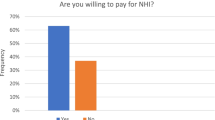Abstract
In many developing countries limited health budgets are a serious problem. Innovative ways to raise funds for the provision of health services, for example, through health care insurance, have a high priority. Health care insurance for rural households shields such patients from unexpected high costs of care. However, there are questions about whether, and how much, rural households are willing to pay to purchase such insurance, as well as the factors determining willingness to pay. In recent years the Iranian government has tried to improve health and medical services to rural areas through a health insurance program. This study was conducted to estimate rural households’ demand and willingness to pay for health insurance. A contingent valuation method (CVM) was applied using an iterative bidding game technique. Data has been collected from a sample of 2,139 households across the country.

Similar content being viewed by others
References
Brook RH (1991) Health, health insurance, and the uninsured. JAMA 265:2998–3002
Akin BV, Rucker L, Hubell A, Cygan RW, Waitzkin H (1987) Access to medical care in a medically indigent population. J Gen Intern Med 4:216–220
McLaughlin CG, Zellers WK (1994) Small business and health care reform. University of Michigan: Ann Arbor
Arrow KJ (1963) Uncertainty and the welfare economics of medical care. Am Econ Rev 53:941–973
Feldstein M (1973) The welfare loss of excess health insurance. J Political Econ 81:251–280
Yoder R (1989) Are people willing and able to pay for health services? Social Sci Med 29:35–42
Hopkins S, Kidd MP (1996) The determinants of the demand for private health insurance under Medicare. Appl Econ 28:1623–1632
Propper C (1989) An econometric analysis of the demand for private health insurance in England and Wales. Appl Econ 21:777–792
Van de Ven WP, van Praag B (1981) The demand for deductibles in health insurance. J Econometrics 17:229–252
Liljas B (1998) The demand for health with uncertainty and insurance. J Health Econ 17:153–170
Kreps D (1990) A course in microeconomic theory. Princeton University Press: Princeton
Besley T, Hall J, Preston I (1999) The demand for private health insurance: do waiting lists matter. J Public Econ 72:155–181
Chernew M, Frick K, McLaughlin CG (1997) The demand for health insurance coverage by low income workers: can reduce premiums achieve full coverage? Health Service Res 32:453–470
Dardanoni V, Wagstaff A (1987) Uncertainty, inequalities in health and the demand for the health. J Health Econ 6:283– 290
Hopkins S, Kidd MP (1996) The determinants of the demand for private health insurance under Medicare. Appl Econ 28:1623–1632
Liljas B (1998) The demand for health, life-time income, and imperfect financial markets. Studies in Health Economics 25, Department of Community Medicine and the Institute of Economic Research. Lund University, Lund
Manning WJ, Newhouse, Duan N, Keeler E, Leibowitz A, Marquis S (1987) Health insurance and the demand for medical care: evidence from a randomized experiment. Am Econ Rev 77:251– 277
Shackley P, Dixon S (2000) Using contingent valuation to elicit public, preferences for water, fluoration. Appl Econ 32:777–779
Zarkin GA, Bala MV, Cates SC (2000) Estimating the willingness to pay for drug abuse treatment. J Subst Abuse Treat 18:149–160
Krieger DJ (1999) The economic value of reducing environmental health risks. J Environ Manage 56:25–35
Diener A, O’Brien B, Gafni A (1998) Health care contingent valuation studies: a review and classification of the literature. Health Econ 7:313–326
O’Brien B, Viramontes JL (1993) Willingness to pay: a valid and reliable measure of health state preference? Med Dec Making 14:289–297
Mitchell RC, Carson RT (1989) Using survey to value public goods: the contingent valuation method. Resources for the Future: Washington
NOAA (1993) Report of the NOAA panel on contingent valuation. Resources for the Future: Washington
Morrison GC, Gyldmark M (1992) Appraising the use of contingent valuation. Health Econ 1:233–243
O’Brien B, Gafni A (1996) When do the ‘dollars’ make sense? Toward a conceptual framework for contingent valuation studies in health care. Med Dec Making 16:288–299
Acknowledgements
This study was financially supported by the Health Care Insurance Organization of Iran and was carried out at the Economic Research Institute at Tarbiat Modares University, Tehran, Iran.
Conflict of interest:
No information supplied.
Author information
Authors and Affiliations
Corresponding author
Appendix 1
Appendix 1
The first IBG group questions were:
-
Suppose that an insurance company would pay 70% of medical care and 90% of hospital expenses for you and your family.
-
Would you be willing to pay 5000 rials per month for this health insurance? (Yes/no)
-
Would you be willing to pay 10,000 rials? (Yes/no)
-
Would you be willing to pay 15,000 rials? (Yes/no)
-
Would you be willing to pay 25,000 rials? (Yes/no)
-
In the second IBG group the insurance fees ranged from 20,000 to 40,000 rials per month.
-
Suppose that an insurance company would pay 70% of medical care and 90% of hospital expenses for you and your family.
-
Would you be willing to pay 20,000 rials per month for this health insurance? (Yes/no)
-
Would you be willing to pay 25,000 rials? (Yes/no)
-
Would you be willing to pay 30,000 rials? (Yes/no)
-
Would you be willing to pay 40,000 rials? (Yes/no)
-
In the third IBG group the insurance fees ranged from 35,000 to 50,000 rials per month:
-
Suppose that an insurance company would pay 70% of medical care and 90% of hospital expenses for you and your family.
-
Would you be willing to pay 35,000 rials per month for this health insurance? (Yes (continue)/no)
-
Would you be willing to pay 40,000 rials? (Yes/no)
-
Would you be willing to pay 45,000 rials? (Yes/no)
-
Would you be willing to pay 50,000 rials? (Yes/no)
-
Rights and permissions
About this article
Cite this article
Asgary, A., Willis, K., Taghvaei, A.A. et al. Estimating rural households’ willingness to pay for health insurance. Eur J Health Econom 5, 209–215 (2004). https://doi.org/10.1007/s10198-004-0233-6
Issue Date:
DOI: https://doi.org/10.1007/s10198-004-0233-6




